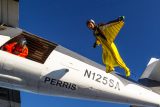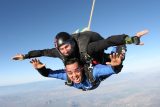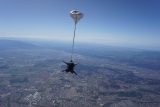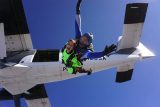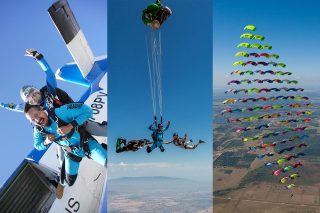
Stay Connected
Get personalized newsletters tailored to your interests! Choose from tandem skydiving, indoor skydiving, fun jumper events, or happenings at the Bombshelter Restaurant and Bar.
Posted by: Skydive Perris
2 years ago
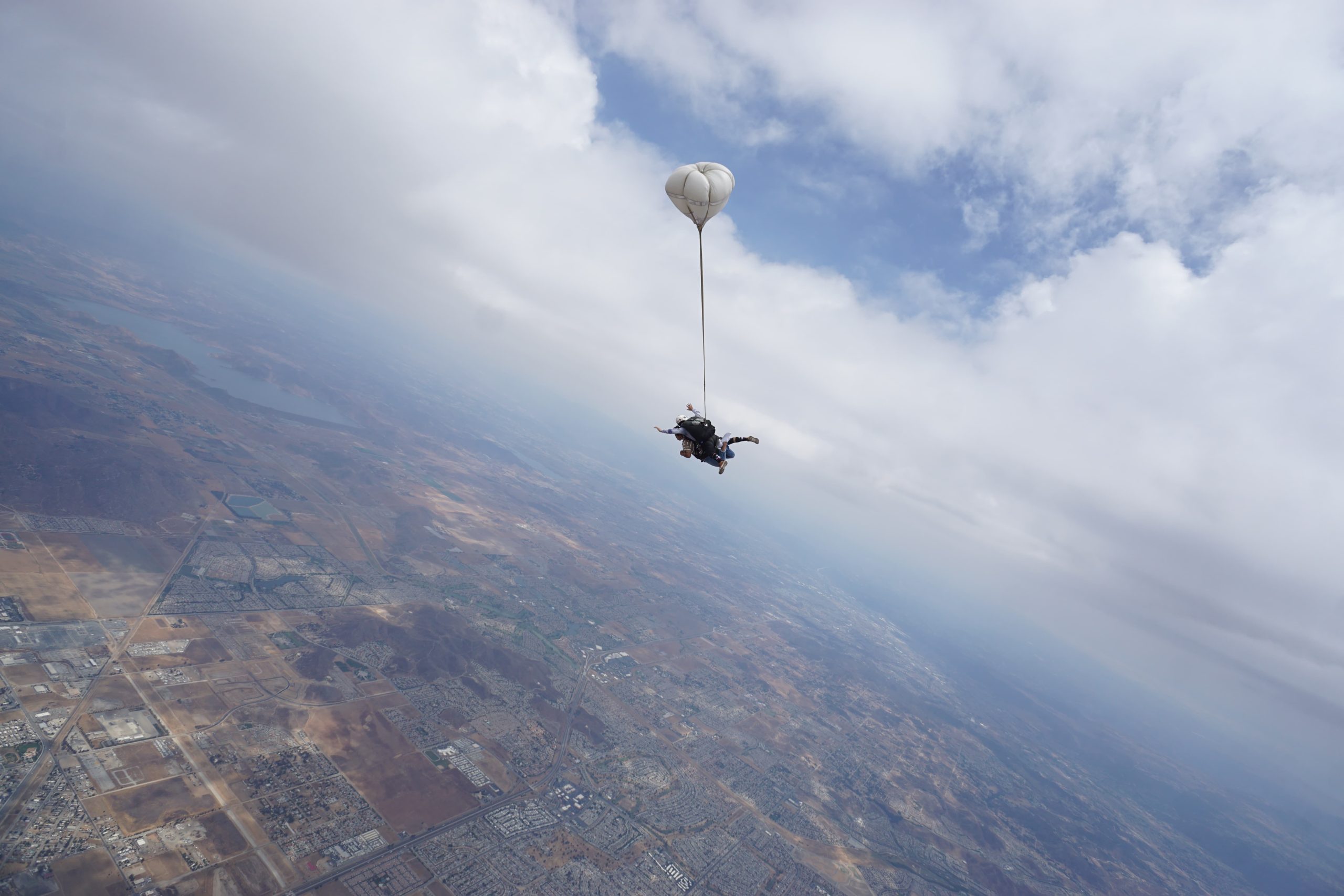
If you look at a picture of a tandem skydiving pair in freefall, you’ll notice a thick bridle extending up above them that ends with what appears to be a small white parachute. If you’re the curious type, you might wonder what that small parachute is for?
But that small white parachute you’ve identified is actually called the drogue. Although tiny in size, it’s impact on the skydiving process is might — keep reading to learn a bit about the drogue and how it works.
The drogue parachute is an elongated round parachute designed to be deployed behind a rapidly moving object, and technically speaking, a drogue is not a proper parachute at all. It’s different from a typical seven- or nine-celled square canopy — a real parachute — in that the drogue is not RAM-Air, meaning the drogue does not generate lift by means of an airfoil design. and does not have steering lines. Drogue parachutes are not designed to fly like a regular square parachute but rather are designed almost solely to aid in deceleration.
Specifically in skydiving, the drogue has a smaller surface area than a regular-sized parachute. Likewise, because the drogue is smaller, it produces less drag, making it perfect for deceleration because it can be deployed at speeds that would shred a conventional sized parachute.
Invented by Russian professor Gleb Kotelnikov, the first iteration of a drogue parachute appeared in 1912. Later, in the 1930s, the drogue parachute helped with the deceleration of aircraft in areas with small or limited landing sites, such as drifting ice stations within the Arctic. Proving successful in aviation, drogue parachutes have also been used on modern jets like the Eurofighter Typhoon. Even today, celestial exploration companies, like SpaceX, use a drogue parachute on space vehicle recovery systems.
So, how did drogue parachutes end up being used for skydiving?
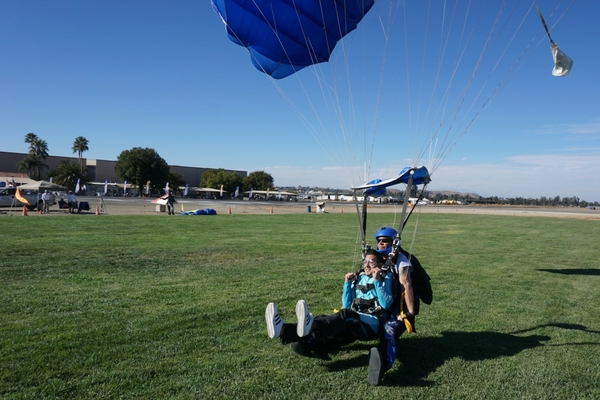
Back in the 1980s, one of the challenges to the development of tandem skydiving was reducing the speed of the tandem pair enough to allow for the safe deployment of a parachute. Ted Strong, the inventor of tandem skydiving, ended up using the drogue parachute to solve this major hurdle in commercial skydiving operations.
In tandem skydiving, the drogue parachute serves a variety of purposes. As we mentioned above, it slows the tandem pair to a terminal velocity that better matches a solo jumper in freefall (120 miles per hour). Without the drogue parachute, a tandem pair would fall closer to 200 miles per hour. If a main parachute was deployed at this speed, it would not just be painful for the instructor and passenger, but also, in many cases, it would cause the main parachute to rip apart. Also, from a “return on investment” standpoint, thanks to the drogue, you just almost doubled the time you spent in freefall before having to deploy the parachute.
In addition to slowing the pair, the drogue also aids in stability, making it easier for instructor and student to maintain a solid, belly-to-earth orientation. And lastly, the drogue parachute is an important part of the parachute deployment sequence on a tandem parachute system. When the instructor pulls the ripcord which opens the skydiving container, the drag created by the drogue extracts the main parachute and allows the freefall portion of the skydive to come to a gentle end.
If Strong didn’t develop a tandem parachute system that utilized a drogue, tandem skydiving would not have gotten off the ground and millions would have missed the opportunity to take flight. Lucky for us, the drogue parachute succeeded.
Want to see the drogue in action? Contact us to schedule your tandem skydive with Skydive Perris today!
Copyright © 2024, Skydive Perris, All Rights Reserved.
Website Design by Beyond Marketing

| Cookie | Duration | Description |
|---|---|---|
| AWSALBCORS | 7 days | Amazon Web Services set this cookie for load balancing. |
| cookielawinfo-checkbox-advertisement | 1 year | Set by the GDPR Cookie Consent plugin, this cookie records the user consent for the cookies in the "Advertisement" category. |
| cookielawinfo-checkbox-analytics | 11 months | This cookie is set by GDPR Cookie Consent plugin. The cookie is used to store the user consent for the cookies in the category "Analytics". |
| cookielawinfo-checkbox-functional | 11 months | The cookie is set by GDPR cookie consent to record the user consent for the cookies in the category "Functional". |
| cookielawinfo-checkbox-necessary | 11 months | This cookie is set by GDPR Cookie Consent plugin. The cookies is used to store the user consent for the cookies in the category "Necessary". |
| cookielawinfo-checkbox-others | 11 months | This cookie is set by GDPR Cookie Consent plugin. The cookie is used to store the user consent for the cookies in the category "Other. |
| cookielawinfo-checkbox-performance | 11 months | This cookie is set by GDPR Cookie Consent plugin. The cookie is used to store the user consent for the cookies in the category "Performance". |
| CookieLawInfoConsent | 1 year | CookieYes sets this cookie to record the default button state of the corresponding category and the status of CCPA. It works only in coordination with the primary cookie. |
| PHPSESSID | session | This cookie is native to PHP applications. The cookie stores and identifies a user's unique session ID to manage user sessions on the website. The cookie is a session cookie and will be deleted when all the browser windows are closed. |
| viewed_cookie_policy | 11 months | The cookie is set by the GDPR Cookie Consent plugin and is used to store whether or not user has consented to the use of cookies. It does not store any personal data. |
| YII_CSRF_TOKEN | session | This cookie is used a unique token that used in securing forms and other website inputs against XSS attacks. |
| __cf_bm | 1 hour | This cookie, set by Cloudflare, is used to support Cloudflare Bot Management. |
| Cookie | Duration | Description |
|---|---|---|
| currency | session | This cookie is used to store the currency preference of the user. |
| lang | session | LinkedIn sets this cookie to remember a user's language setting. |
| Cookie | Duration | Description |
|---|---|---|
| AWSALB | 7 days | AWSALB is an application load balancer cookie set by Amazon Web Services to map the session to the target. |
| Cookie | Duration | Description |
|---|---|---|
| ahoy_visit | 4 hours | This cookie is set by Powr for analytics measurement. |
| ahoy_visitor | 1 year 1 month 4 days | This cookie is set by Powr for analytics measurement. |
| CONSENT | 2 years | YouTube sets this cookie via embedded YouTube videos and registers anonymous statistical data. |
| vuid | 1 year 1 month 4 days | Vimeo installs this cookie to collect tracking information by setting a unique ID to embed videos on the website. |
| _fbp | 3 months | Facebook sets this cookie to display advertisements when either on Facebook or on a digital platform powered by Facebook advertising after visiting the website. |
| _ga | 1 year 1 month 4 days | Google Analytics sets this cookie to calculate visitor, session and campaign data and track site usage for the site's analytics report. The cookie stores information anonymously and assigns a randomly generated number to recognise unique visitors. |
| _gat_UA-* | 1 minute | Google Analytics sets this cookie for user behaviour tracking. |
| _ga_* | 1 year 1 month 4 days | Google Analytics sets this cookie to store and count page views. |
| _gcl_au | 3 months | Google Tag Manager sets the cookie to experiment advertisement efficiency of websites using their services. |
| _gid | 1 day | Google Analytics sets this cookie to store information on how visitors use a website while also creating an analytics report of the website's performance. Some of the collected data includes the number of visitors, their source, and the pages they visit anonymously. |
| Cookie | Duration | Description |
|---|---|---|
| fr | 3 months | Facebook sets this cookie to show relevant advertisements by tracking user behaviour across the web, on sites with Facebook pixel or Facebook social plugin. |
| IDE | 1 year 24 days | Google DoubleClick IDE cookies store information about how the user uses the website to present them with relevant ads according to the user profile. |
| test_cookie | 15 minutes | doubleclick.net sets this cookie to determine if the user's browser supports cookies. |
| VISITOR_INFO1_LIVE | 6 months | YouTube sets this cookie to measure bandwidth, determining whether the user gets the new or old player interface. |
| YSC | session | Youtube sets this cookie to track the views of embedded videos on Youtube pages. |
| yt-remote-connected-devices | never | YouTube sets this cookie to store the user's video preferences using embedded YouTube videos. |
| yt-remote-device-id | never | YouTube sets this cookie to store the user's video preferences using embedded YouTube videos. |
| yt.innertube::nextId | never | YouTube sets this cookie to register a unique ID to store data on what videos from YouTube the user has seen. |
| yt.innertube::requests | never | YouTube sets this cookie to register a unique ID to store data on what videos from YouTube the user has seen. |
| Cookie | Duration | Description |
|---|---|---|
| ahoy_track | session | No description available. |
| currencyBase | session | No description available. |
| currencySymbol | session | Description is currently not available. |
| landingCatalogURL | session | No description available. |
| test-third-party-cookie | session | Description is currently not available. |
| VISITOR_PRIVACY_METADATA | 6 months | Description is currently not available. |
